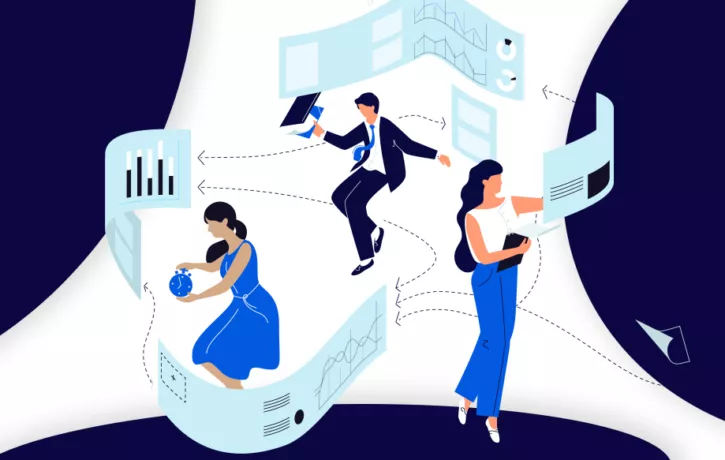No one wants to be a “cog in the machine.” In the digital era, this expression has an entirely new meaning.
Digital is not only changing how we work, but how we experience work.
As investments in digital transformation rise, employees are expected to continually add new tools to their workflow. New apps and systems promise to raise productivity, increase innovation, and enhance competitiveness. But in reality, poor usability on software is a persistent problem, and it usually leads to the opposite outcomes.
Slower outputs are only one consequence. In the digital workplace, the employee experience is more vulnerable than ever.
Widespread employee frustration with enterprise technology has far-reaching consequences, from stress to disengagement to turnover.
The question is, in the evolving digital workplace, how do you preserve a “human” employee experience?
The broken promise of digital transformation
Competing in the digital age requires advanced digital capabilities both internally and within the business model.
Organizations across nearly all industries are racing to keep up. Global investments in digital transformation technology are expected to reach $1.18 trillion by the end of 2019, according to predictions from the IDC.
You may be enthusiastic about technology’s potential to increase key business performance metrics, such as productivity, cost reduction, and revenue. But employees seldom share this excitement.
Why? Because being “in the trenches” of work can mean shuffling between upwards of a dozen platforms throughout the day, and it’s not easy.
Ineffective onboarding, confusing interfaces, and complex processes are major contributors to employee frustration and disengagement. As you add more tools to your staff’s workflow, these problems only get worse. In addition to wreaking havoc on your employee experience, business performance will take a serious hit.
Poor usability is taking a toll
We recently conducted a survey to understand just how workplace technology affects the employee experience. The results are clear: poor usability on enterprise software imposes a heavy burden on employees.
Here are some key findings:
- A mere 14.5% of employees say they are “very satisfied” with the usability of their workplace software.
- Less than one-third (28.2%) say the digital tools they use at work enable them to improve their productivity and fulfill their responsibilities.
- While 75.3% of leaders believe workplace software boosts employees’ well-being by enhancing their capabilities, just 54.2% of workers say this is true.
When you realize that virtually every aspect of a knowledge worker’s day takes place on digital software, it’s easy to understand just how stressful poor usability can be. Left unresolved, this stress can manifest into something much more harmful, such as burnout.
What’s driving the problem?
The issue of software usability is tricky. In some cases, complex or non-intuitive interfaces can be improved with better UX design. But often, enterprise tools are too difficult to use simply because  they are packed with so many features.
they are packed with so many features.
The more capable a software, the more there is to learn.
When this is the case, poor usability and the frustration it generates boils down to a lack of digital adoption.
Poor digital adoption is hurting your employee experience
We define digital adoption as a person’s ability to use digital tools as they are intended and with the full range of capabilities.
The level of digital adoption in your organization not only determines how successful your digital transformation efforts will be, but it also has a direct influence on the overall employee experience.
As long as poor usability persists, digital adoption will remain out of reach.
According to our survey, employees cited the following factors as the biggest barriers to software usability:
- Inadequate training — indicated by 74.1% of employees
- Complex and confusing interface — 43.6%
- Lack of guided learning tools — 34.2%
Unless you provide employees with effective training and support tools, it will be impossible for them to use it. And if they feel like pulling out their hair every time they need to use the software, their overall experience will suffer.
Like what you’re reading? Subscribe to the blog for fresh insights delivered right to your inbox!
Don’t overlook your human users
The answer to preserving a “human” employee experience in the digital age is not to get rid of technology. It’s to stop it from becoming a source of stress and frustration. If your digital tools allowed employees to accomplish what they promised, everyone would be happy.
The solution is to give employees everything they’re asking for. Better training, a way to navigate complex interfaces, and guided learning tools.
Basically, they’re asking for a Digital Adoption Platform (DAP).
Provide training that actually works
According to the survey, the need to ditch outdated training models is clear. Classroom sessions, instruction manuals, or webinars are simply not equipped to cover the breadth of content necessary to prepare employees to use advanced digital tools.
to prepare employees to use advanced digital tools.
Moreover, frequent updates from the cloud mean employees need additional training on a routine basis.
Instead, training that enables contextual learning is far more effective. The DAP uses an algorithm that analyzes a range of contextual factors (such as the task at hand, the user’s goals, position, and many others) in order to provide tailored training in the moment of need.
With contextual learning, employees can quickly onboard to new systems and processes in the moment of need. Instead of spending extra time completing training sessions, they can “learn in the flow of work.”
Guide users through any task
The DAP’s navigational guidance is the answer to employees’ desire for simplified interfaces and guided learning tools.
With on-screen, real-time support, the DAP literally walks users through processes step-by-step to ensure they don’t get lost or confused. The need to parse through complex interfaces and figure out how to complete confusing processes disappears.
With this guidance, any employee can complete even the most complex tasks, regardless of their previous experience on the platform
Keep your humans happy
Resolving the usability issue is essential to ensuring a positive employee experience in the digital era.
With an effective digital adoption solution, you can prevent software frustration, reduce stress, and boost productivity. It’s a win-win-win.
WalkMe’s Digital Adoption Platform (DAP) transforms the user experience in today’s overwhelming digital world. Using artificial intelligence, engagement, guidance, and automation, WalkMe’s transparent overlay assists users to complete tasks easily within any enterprise software, mobile application or website. Discover how a DAP can revolutionize your business.

